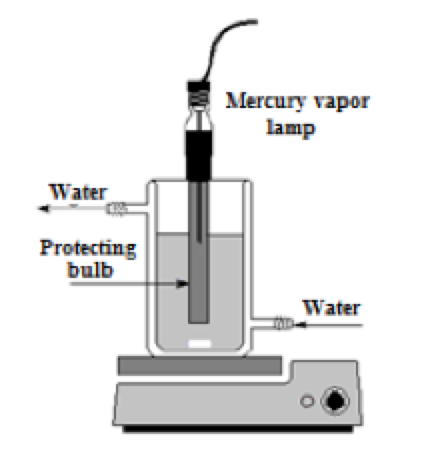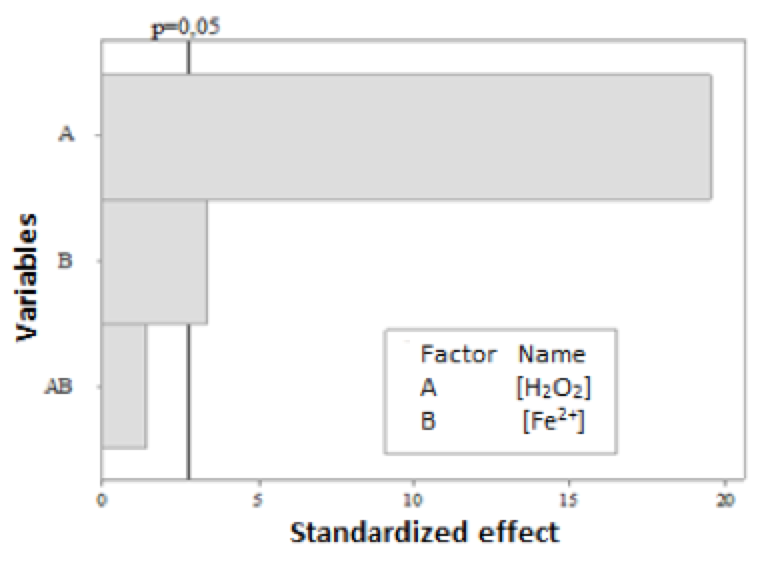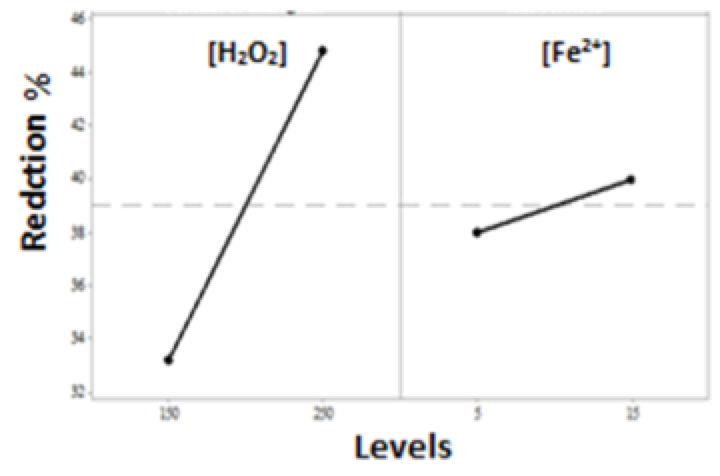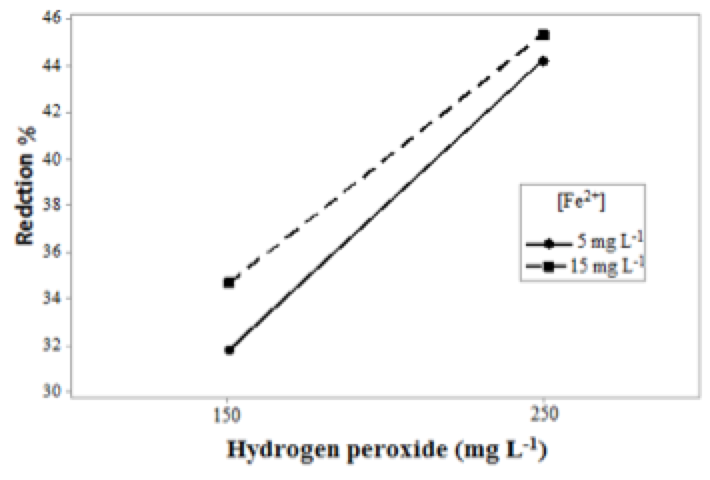

Vol. 38 (Nº 27) Año 2017. Pág. 12
Erivelton César STROPARO 1; Kely Viviane de SOUZA 1; David Cardoso DOURADO 1; Everton Lorenzett TAVARES 2; Waldir Nagel SCHIRMER 1
Recibido: 18/12/16 • Aprobado: 24/01/2017
ABSTRACT: In this study, an evaluation was carried out of the efficiency of photo-degradation of effluents resulting from biodiesel purification by photo-Fenton process with the help of factorial design 22, having as variables the concentrations of H2O2 and Fe2+. The results suggest that the two variables are significant for treatment. However, they can be optimized in an independent manner, since variable H2O2 resulted in a relative increase of 36 % in reducing the spectral area when its concentration varied from 150 mg L-1 to 250 mg L-1. In the case of variable Fe2+, there was a relative increase of 5% on the reduction of spectral area when concentration varied from 5 mg L-1 to 15 mg L-1. |
RESUMO: Neste trabalho foi avaliada a eficiência de fotodegradação do efluente proveniente da purificação do biodiesel por processo foto-Fenton com o auxilio de planejamento fatorial 22, tendo como variáveis a concentração de H2O2 e de Fe2+. Os resultados sugerem que as duas variáveis são significativas no tratamento. No entanto, as mesmas podem ser otimizadas de forma independente, sendo que a variável H2O2 implicou num aumento relativo de 36 % na redução da área espectral quando variou sua concentração de 150 mg.L-1 para 250 mg.L-1. Tratando-se da variável Fe2+, ocorreu um aumento relativo de 5 % na redução da área espectral quando variou-se a concentração de 5 mg.L-1 para 15 mg.L-1. |
Data recently surveyed by World Energy Outlook (IEA, 2015) state that oil (a non-renewable natural resource) is the main global energy matrix. Pollution generated during its drilling, transportation, processing, and burning its products (especially CO2 emissions, which is responsible for intensifying greenhouse effect) are considered the greatest disadvantages of using this energy source. Within this context, new sources have been sought, especially renewable ones (Mesaric and Krajcar, 2015).
A possible alternative to oil is the use of biodiesel. In addition to coming from renewable resources and thus contributing to decreased CO2 emissions into the atmosphere, this fuel is easily degradable when compared to oil products (Palomino-Romero et al., 2012).
Biodiesel is produced from vegetable oils, animal fats, and even residues, such as frying oil. In regards to oilseeds, the most used are soybeans, jatropha, castor beans, palm, sunflower seeds, and canola, these raw materials present efficiency in terms of fatty acids, as well as being easy to cultivate and extract oil (Kligerman and Bouwer, 2015).
Regardless of the raw material it results from, biodiesel is defined as a mix of alkyl esters of fatty acids, usually obtained through trans-esterification reaction (Knothe, 2006). This reaction takes place in the presence of a catalyst (acidic, basic, or enzymatic) in an alcoholic environment, resulting in biodiesel as the main product and glycerin as byproduct (Fukuda, Kondo and Noda, 2001).
Due to the use of catalysts in biodiesel synthesis, neutralization and purification are necessary before it is employed, since the absence or inefficiency of biodiesel purification process may result in damages in the engine such as obstruction of filters, nozzles, wear of the engine and its parts, among other mechanical problems (Atadashi et al., 2011; Demirbas, 2009 and Stojković, 2014). Among the many biodiesel purification processes, one of the most used is the adding of aqueous solutions or distilled water to it. In addition, according to these authors, this process presents the disadvantage of generating wastewater that must be separated from biodiesel and treated later (Stojković, 2014).
According to Veljkković (2014) wastewater resulting from "wash water" purification is comprised of oils and non-trans-esterified fatty acids, catalysts, salts, soaps, and organic impurities, and it presents high SS, COD, and BOD values and concentration of other organic compounds, a fact that grants it low biodegradability. Therefore, this wastewater is harmful to the environment and cannot be discharged into wastewater collection and transportation systems or bodies of water without a proper treatment (Daud, 2014)
In regards to treatment of wastewater originating from biodiesel washing, there are many Technologies that may be employed, including biological, chemical, and physical processes (Pitakpoolsil and Hunsom, 2014). Within this context, Advanced Oxidation Processes (AOPs), which are based on the formation of hydroxyl (OH), which presents a high reduction potential (E0= 2.8 V), that presents high instability, capable of react with a great range of organic compounds, promoting their mineralization, even CO2 and H2O (Nogueira and Jardim, 1998; Nogueira et al., 2007). Among the several types of AOPs, Fenton and photo-Fenton processes stand out because of their high efficiency and operational simplicity (Nogueira et al., 2007).
Fenton process is characterized by the reaction between ferrous ion (Fe2+) and hydrogen peroxide (H2O2), resulting in hydroxyl (Nogueira et al., 2007, Wu et al., 1999). Even though the Fenton process is an alternative in the degradation of several environmental pollutants, its efficiency can be significantly improved if it is assisted by ultraviolet (UV) radiation sources or Visible (Vis), thus characterizing the process as photo-Fenton (Freire et al,. 2000). Photo-Fenton process is one of the most efficient advanced oxidation processes when a high decrease is needed of organic matter content in wastewater from biodiesel washing (Veljković et al., 2014). The application is also emphasized of photo-Fenton process in the treatment of several types of wastewater from textile industry, dairy, and paint industry, among others (Martins et al., 2011; Punzi et al., 2015; Villa, Silva and Nogueira, 2007).
Even though it Has Been little explored, the application of photo-Fenton in the treatment of wastewater from biodiesel washing has already Been investigated in studies by Hincapié-Mejia (2011), Veljković, Stamenković and Tasić (2014) with removal efficiency in COD for wastewater (with different chemical features).
The greatest advantage of the presence of radiation (either artificial or natural) is that regeneration of ferrous species takes place, reacting with H2O2 from the environment, thus closing the catalytic cycle and resulting in two hydroxyl radicals for each mole of initially decomposed H2O2 (Nogueira et al., 2007; Ghaly et al., 2001).
In the face of both the high pollution potential by wastewater from biodiesel purification, especially regarding hydric resources, and the simplicity and efficiency of some chemical treatment processes applied to this type of wastewater, the goal of this study is to verify the influence of variation of hydrogen peroxide and Fe2+ concentrations in the efficiency of the degradation process by photo-Fenton of pollutants present in wastewater from biodiesel washing. A 22 factorial planning was applied to this end.
For photo-degradation essays by photo-Fenton, a sample of wastewater from biodiesel washing was collected in an industrial plant that produces bio-fuel by mixing soybean oil and tallow (via methyl route), which is located in the town of Marialva, state of Paraná.
Photo-Fenton process
Treatment essays of wastewater from biodiesel washing, using photo-Fenton process, were carried out according to the methodology proposed in literature (Oliveira, Nogueira and Neto, 2001). As a source of radiation for the photo-Fenton process, a 125 W mercury vapor lamp was used, coupled to a bench photochemical reactor with volume of 250 mL which was kept in magnetic stirring. A scheme of the bench photochemical reactor used in this study is presented in Figure 1.

Figure 1 Schematic representation of the photochemical reactor, which is
operated with artificial radiation from the mercury vapor lamp
The adopted period of time for wastewater treatment was 30 minutes, similar to that used in the study by Grangeiro et al., (2014). For analysis of treatment efficiency, spectroscopic scan assays within the ultraviolet and visible range in the 200-750 mm wavelength for raw wastewater and treated (a spectrophotometer HACH/DR6000 was employed for that end), according to the methodology adopted by Brito (2012); Marmitt (2010). The speed, low-cost, non-use of chemical reagents and the absence of generation of residues are some of the advantages of using this methodology.
With aid from Origin 8.0 software, the area corresponding to each curve obtained in spectroscopic assays was calculated, which relates directly to the concentration of pollutants in the sample and thus the results were analyzed in terms of its decrease in percentage.
The influence of the figures of hydrogen peroxide (H2O2) concentration and ferrous ions (Fe2+) in the process of degradation in biodiesel samples was investigated by a 22 factorial design, each factor was studied at two levels (Neto, Scarminio and Bruns, 2010). The photo-degradation assays (performed in duplicate) were carried out in a random fashion for all combinations of factor levels presented in Table 1.
Table 1 Factors and levels of 22 factorial design for decreasing pollutants
from biodiesel washing water by photo-Fenton process
Factor |
Level (-) |
Level (+) |
(1) H2O2 concentration (mg L-1) (2) Fe2+ concentration (mg L-1) |
150 5 |
250 15 |
The effects of the factorial design factors (Ef) were calculated according to Equation 1:
Ef = (R+) – (R-) (Equation 1)
In which R+ and R- are the differences between the averages of levels (+) and (-), respectively, of the factors involved.
The effects of variables in the decrease of spectral area were tested for the statistical significance to the 95 % level, by the calculation of standard error. The statistical analysis of the data was carried out using the “Minitab 17” application.
The photo-degradation process of biodiesel wash water by photo-Fenton studied in the factorial design made it evident a significant decrease in organic compounds over a 30-minute span, and its results are presented in Table 2, and the calculations of the effects in Table 3.
Table 2 Calculation of the effects and their respective standard deviations for
22 factorial design to determine the percentage of degradation of pollutants
in wastewater from biodiesel wash through photo-Fenton process
[Fe2+] |
[H2O2] |
% Decrease averages ± standard deviation |
(-) 5 |
(-) 150 |
31.76 ± 0,032 |
(+) 15 |
(-) 150 |
44.14 ± 0,027 |
(-) 5 |
(+) 250 |
34.65 ± 5,049 |
(+) 15 |
(+) 250 |
45.35 ± 0,478 |
By F-test and T-test analysis at 95 % of confidence, it was found that the two variables of the design (H2O2 concentration and Fe2+ concentration) were considered as significant, however, a significant interaction effect was not observed between the two variables investigated in the process (Table 3 and Figure 2). Therefore, the H2O2 concentration and Fe2+ concentration variables may be independently optimized.
Table 3 Calculation of the average effects and their standard errors for
22 factorial design to determine the percentage of degradation of pollutants
in wastewater from biodiesel wash through photo-Fenton process
Effects |
Estimate ± standard error* |
Global average
|
38,97 ± 0,11 |
Efeitos principais: |
|
|
|
[H2O2] (1) |
20,40 ± 0,21 |
[Fe2+] (2) |
11,55 ± 0,21 |
Interaction between two factors: (1) x (2) |
-0,8377 ± 0,21 |
* the standard error of the effects was calculated based
on the standard deviations presented in Table 2.

Figure 2 Pareto chart for the standardized effects of
22 factorial design at a 95 % confidence level
The change of the level of the H2O2 concentration variable from 150 mg L-1 to 250 mg L-1 resulted in a relative increase of approximately 36 % in decreased pollutants in the sample, regardless of the level of the Fe2+ concentration variable (Figure 3). This fact may be explained due to wastewater from biodiesel washing presenting high methanol concentrations, which acts as abductor of hydroxyl resulting in decreased efficiency of the process in low H2O2 concentrations (Nogueira, 2007). However, higher Fe2+ concentrations (15 mg L-1) regardless of the adopted H2O2 concentration (150 or 250 mg L-1), presented a relative reduction percentage of approximately 5,0 % higher when compared to lower Fe2+ levels. Even though the result presents an increase in reduction percentage, from an environmental standpoint the use of lower concentrations of iron is more appropriate, since 15 mg L-1 is the maximum concentration allowed for discharge into bodies of water according to CONAMA resolution 357/2005 in addition to being more economically feasible. Therefore, lower iron concentrations are suggested for the due treatment without any significant losses in the efficiency of the treatment.

Figure 3 Diagram for the interpretation of the effects of 22 factorial design
to determine degradation percentage of pollutants present in wastewater
from biodiesel washing through photo-Fenton process
In addition to the main effects, no interaction effects were observed between the significant factors (Fe2+ and H2O2) as shown in Figure 3, which confirms the results presented in Table 2.

Figure 4 Graph of the effect of the interaction between
H2O2 and Fe2+ concentrations for 22 design
By way of Figure 4, one can also notice that the factors may be analyzed separately, because their effects do not depend on the levels of the other variables.
Results from factorial design suggest that the variables investigated of H2O2 and Fe2+concentrations influence the photo-degradation process of the photo-Fenton type of water resulting from biodiesel purification. However, the influence of H2O2 concentration is more significant than that of Fe2+. The results also show that no significant interaction effects were observed between the two variables; therefore, they may be analyzed separately.
It is suggested that in order to perform a more complete analysis of the photo-degradation process optimization, an increase of other variables that might directly affect its efficiency, such as treatment time, types of radiation sources, and geometry of the reactor.
Atadashi I M, Aroua M K, Aziz A R A, Sulaiman N M N (2011) Refining Technologies for the purification of crude biodiesel. Applied Energy 88:4239-4251
Brito J F, Ferreira L O, Silva J P (2012) Tratamento da água de purificação do biodiesel utilizando eletrofluculação. Química Nova 35:728-732
Conselho Nacional do Meio Ambiente. Resolução nº 357, de 17 de março de 2005. Dispõe sobre a classificação dos corpos de água e diretrizes ambientais para o seu enquadramento, bem como estabelece as condições e padrões de lançamento de efluentes, e dá outras providências. Diário Oficial da União da República Federativa do Brasil, Brasília, DF, 18 mar. 2005. Seção 1, p. 58-63. Disponível em: <http://www.mma.gov.br/port/conama/legiabre.cfm?codlegi=459>. Accessed on: March 2, 2015
Daud N M, Adbdullah S R S, Hasan H A, Yaakob Z (2014) Production of biodiesel and its wastewater treatment technologies: A review. Process Safety and Environmental Protection 94:487-508
Demirbas, A (2009). Progress and recent trends in biodiesel fuels. Energy Conversion and Management 50:14-34
Freire R S, Pelegrini R, Kubota L T, Durán N, Zamora P P (2000) Novas tendências para tratamento de resíduos industriais contendo espécies organocloradas. Química Nova 23:504-511
Fukuda H, Kondo A, Noda H (2001) Biodiesel fuel production by transesterification of oils. Journal of Bioscience and Bioengineering 92:405–416
Kligerman D C, Bouwer E J (2015) Prospects for biodiesel production from algae-based wastewater treatment in Brazil: A review. Renewable and Sustainable Energy Reviews 52:1834–1846
Ghaly M Y, Hartel G, Mayer R, Haseneder R (2001) Photochemical oxidation of p-chlophenol by UV/H2O2 and photo-Fenton process. A comparative study. Waste Management 21:41-47
Grangeiro R V T, Melo M A R, Silva E V, Souza A G, Toscano I A S (2014) Caracterização física, química e toxicológica da água de lavagem gerada na produção de biodiesel. Revista Verde de Agroecologia e Desenvolvimento Sustentável 9:78-83
Hincapié-Mejia G M, Campo D, Restrepo G M, Marin J M (2011) Fotocatálisis Heterogénea y Foto-Fenton Aplicadas al Tratamiento de Aguas de Lavado de la Producción de Biodiesel. Inf. tecnol. 22:33-42
IEA. World energy outlook (2012) International Energy Agency, Head of Communication and Information Office: Paris, France; 2012. Disponível em〈http://www.iea.org/publications/freepublications/publication/name-49561-en.html〉 (acessado em: 27/08/2015)
Knothe G, Gerpen V J, Krahl J, Ramos P L (2006) Manual do Biodiesel. São Paulo: Edgard Blücher
Marmitt S, Pirotta L V, Stulp S (2010) Aplicação de Fotólise direta de UV/H2O2 a efluente sintético contendo diferentes corantes alimentícios, Química Nova 33:384-388
Martins L M, Silva C E, Neto J M M, Lima A S, Moreira R F P M (2011) Aplicação de Fenton, foto-Fenton e UV/H2 O2 no tratamento de efluente têxtil sintético contendo o corante Preto Biozol UC. Eng Sanit Ambient 16:261-270
Mesaric P, Krajcar S (2015) Home demand side management integrated with electric vehicles and renewable energy sources. Energy and Buildings 108:1-9
Neto B B, Scarminio I S, Bruns R E (2010) Como fazer experimentos, 4ª ed., Unicamp: Campinas
Nogueira R F P, Jardim W F (1998) A fotocatálise heterogênea e sua aplicação ambiental. Química Nova 21:69-72
Nogueira R F P, Trovó A G, Silva M R A, Villa R D (2007) Fundamentos e Aplicações ambientais dos processos fenton e foto-Fenton. Química Nova 30:400-408
Oliveira M C, Nogueira R F P, Neto J A G (2001) Sistema de injeção em fluxo espectrofotométrico para monitorar peroxido de hidrogênio em processo de fotodegradação por reação foto-Fenton. Química Nova, n. 24:188-190
Palomino-Romero J A, Leite O M, Eguiluz K I B, Salazar-Banda G R, Silva D P, Cavalcanti E B (2012) Tratamento dos efluentes gerados na produção de biodiesel. Química Nova 2:367-378
Pitakpoolsil W, Hunsom M (2014) Treatment of biodiesel wastewater by adsorption with commercial chitosan flakes: Parameter optimization and process kinetics. Journal of Environmental Management 133:284-292
Punzi M, Anbalagan A, Börner R A, Svensson B, Jonstrup M, Mattiasson B (2015) Degradation of a textile azo dye using biological treatment followed by photo-Fenton oxidation: Evaluation of toxicity and microbial community structure. Chemical Engineering Journal 270:290-299
Stojković I J (2014) Purification technologies for crude biodiesel obtained by alkali-catalyzed transesterification. Renewable And Sustainable Energy Reviews 32:1-15
Veljković V B, Stamenković O S, Tasić M B (2014) The wastewater treatment in the biodiesel production with alkali-catalyzed transesterification. Renewable and sustainable energy reviews 32:40-60
Veljković V B, Tsehung Y, Banković-Ilić I B, Stojković I J, Stamenković O S (2014) Waste animal fats as feedstocks for biodiesel production. Renewable and sustainable energy reviews 32:238-254
Villa R D, Silva A S, Nogueira P (2007) Potencial de aplicação do processo foto-Fenton/solar como pré-tratamento de efluente da indústria de laticínios. Química Nova 30:1799-1803
Wu K, Xie Y, Zhao J Hidaka, H (1999) Photo-Fenton degradation of a dye under visible light irradiation. Journal of Molecular Catalysis A: Chemical 144:77-84
1. Professor do Departamento Engenharia Ambiental da Universidade Estadual do Centro-Oeste. Email: stroparo.erivelton@gmail.com
2. Mestrando em Ciências Florestais, na Universidade Estadual do Centro-oeste.